Written by: Jeremy Koch, Messari
Translated by: Yomi
Key Insights
- Autonomys Network has established a modular blockchain architecture based on the Subspace Protocol, creating the necessary infrastructure for AI3.0 applications.
- To achieve high scalability, Autonomys Network integrates Decoupled Execution (DecEx), modular domains, data sharding, and a multi-layer distributed storage network (DSN). The DSN also supports AI Agents to directly store and retrieve on-chain data.
- The network employs a consensus mechanism called Dilithium, which is an archival storage proof (PoAS) combined with a Proof of Time (PoT) mechanism, allowing miners to solve the "miner dilemma" by maintaining consensus without storing the entire blockchain history, ensuring data availability, security, and efficient storage management.
- Auto ID and Auto Score create a self-sovereign identity framework and personality proof mechanism, promoting verifiable human-machine interactions.
- Space Acres simplifies the process for users to participate in the Autonomys Network. This convenient application allows anyone to run a miner node on their own computer to earn AI3 tokens.
Introduction
In recent years, the rise of artificial intelligence has captured the majority of market attention. From the advent of GPT-3.0 to the emergence of on-chain AI Agents, there is great anticipation about how AI will reshape the way the world operates. However, a core issue facing AI is its positioning within a decentralized framework. Currently, leading AI models remain centralized and require permission for access. As a result, the democratization of AI access is becoming an inevitable trend. Giants like Meta are attempting to achieve this democratization through open-sourcing Llama3.1. Such a transformative scale can be traced back to 2009 when Satoshi Nakamoto created Bitcoin. To build a world where everyone can freely use disruptive technology, more projects like Meta and Bitcoin are needed to jointly explore the true value of open source and permissionless systems.
The vision of Autonomys Network is in line with Satoshi Nakamoto's: to create a permissionless and secure blockchain ecosystem while extending this concept to the infrastructure development of AI3.0, making it a public good. AI3.0 represents an open, collaborative, and Web3-supporting path for AI development. In this model, individuals can freely customize, train, and deploy their own intelligent agents to assist them in completing tasks. Artificial intelligence is evolving from centralized machine learning AI1.0, to centralized generative AI AI2.0, and now towards a human-centered decentralized AI3.0.
As a cornerstone of AI3.0, Autonomys Network is built on the Subspace Protocol, providing the infrastructure and tools necessary for this new phase, dedicated to solving challenges related to scalability, security, data sourcing, and user control. With a focus on decentralization, human-centricity, and open collaboration, Autonomys is leading artificial intelligence into a future era that is fairer, more valuable, and aligned with human values.
Background
Autonomys Network is the practical outcome based on the Subspace Protocol, developed over three years by co-founders Jeremiah Wagstaff and Nazar Mokrynsky. The Subspace Protocol enables permanent decentralized storage functionality for Web3. Building on this foundation, Jeremiah and Nazar successfully integrated decoupled modular computing, leading to the launch of Autonomys Network. On June 14, 2024, the protocol announced its official rebranding to Autonomys Network.
The project has raised 32.9 million dollars, led by Pantera Capital, with participation from well-known institutions including Coinbase Ventures, Crypto.com, KR1, GSR Ventures, Alumni Ventures, Hypersphere Ventures, and Stratos Technologies.
Autonomys Network has undergone seven testnet iterations, attracting over 100,000 miners (participants) and providing more than 180 PiB of storage space support. On November 6, 2024, the first phase of the Autonomys mainnet officially launched, using a mnemonic phrase generation ceremony for Proof-of-Time, with the hash of Bitcoin block #869146 serving as the global starting point for the network. Within two weeks of the mainnet launch, the network added over 2,000 nodes, contributing more than 140 PiB of storage capacity. The native token of Autonomys Network is AI3, which can be used for staking, governance, block rewards, and transaction fee payments, serving as a crucial pillar for the network's operation.
Technology
Autonomys Network Technology Stack
Autonomys Network adopts a modular blockchain architecture, divided into four main parts: (i) decentralized application (dAPP) layer, (ii) decoupled execution domain, (iii) consensus layer, and (iv) storage layer.
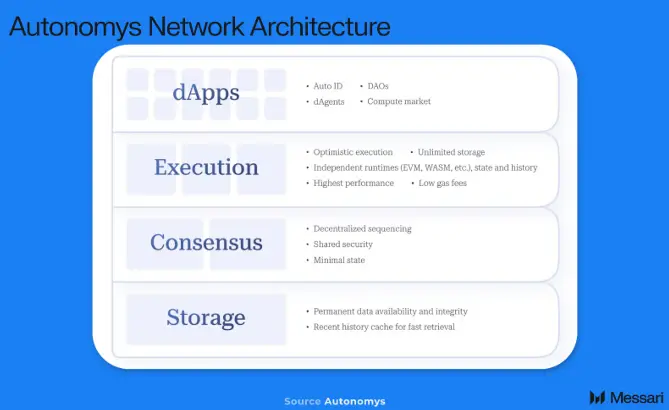
The modular design of Autonomys Network features several core functionalities, including Decoupled Execution (DecEx), Domains, Interoperability, Data Sharding, and an open-source AI directory.
- Decoupled Execution: Separates transaction execution from consensus, allowing the network to independently scale throughput and storage capacity while maintaining decentralization.
- Domains: Allow developers to build specific application blockchains with custom functionalities, supporting diverse AI application scenarios while avoiding overloading the core protocol.
- Interoperability: Supports integration with different state transition frameworks and execution environments (such as EVM and WASM), facilitating seamless connections with existing blockchain ecosystems.
- Data Sharding: Divides data into multiple shards distributed across different nodes, supporting parallel processing, reducing the load on individual nodes, and enhancing the network's ability to handle large-scale datasets, providing support for AI training and deployment.
- Open-source AI Directory: Hosts a dedicated open-source AI resource library, promoting collaboration and innovation within the AI3.0 ecosystem, fostering knowledge sharing, and protecting valuable AI resources from censorship threats.
Autonomys Network plans to achieve high throughput through its scalability framework. This framework includes data sharding capable of parallel processing transactions, a beacon chain utilizing a unique Proof-of-Archival Storage (PoAS) consensus mechanism, and domains. Currently, blockchain storage capacity is limited, making it difficult to reach scalable levels. Autonomys's scalability framework aims not only to break through this bottleneck but also to achieve throughput levels comparable to existing Web2 systems in storage, bandwidth, and computing power, providing strong support for building a more efficient decentralized application ecosystem.
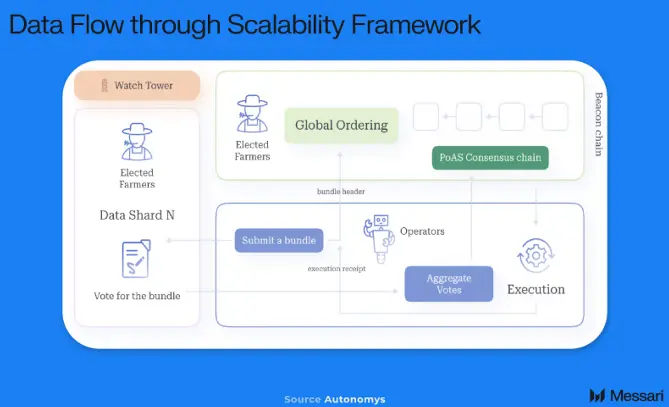
Consensus Mechanism
The consensus mechanism of Autonomys Network is based on a PoAS protocol design called Dilithium. Dilithium is optimized for the characteristics of SSDs, relying on a mechanism that frequently reads small data blocks randomly, making it more efficient on such storage devices. The core functionalities of Dilithium include Archiving, Plotting, Farming, Proving, and Verification. The operation of these functions relies not only on Dilithium itself but also benefits from a Proof-of-Time (PoT) blockchain that runs in parallel with the PoAS blockchain. The design goal of the PoT blockchain is to simulate the advantages of Proof of Work (PoW) while avoiding its high energy consumption issues. By introducing verifiable time constraints, PoT enhances network security, making it difficult for malicious actors to create long-term historical forks. Additionally, the output of PoT provides unpredictable randomness, a mechanism similar to the randomness generated in PoW mining for block challenges, further enhancing the fairness and reliability of consensus. To maintain the operation of the PoT blockchain, the network introduces "Timekeepers," specialized nodes responsible for calculating the Delay Function, generating unpredictable outputs that serve as a source of randomness for creating block challenges. Through this mechanism, Autonomys Network achieves efficient, secure, and scalable blockchain consensus.
The PoAS consensus mechanism can be divided into the following three main stages:
- Archiving Stage: This stage is completed by all nodes and is characterized by repeatability and determinism. The task of Archiving is to split the historical data of the blockchain into several segments, each consisting of equally sized data blocks.
- Plotting Stage: In this stage, miners are responsible for processing and encoding the segments of blockchain historical data assigned to them and storing them.
- Auditing Stage: This stage employs probabilistic methods to audit the data stored by miners to verify data integrity. At the same time, miners have the opportunity to propose new blocks.
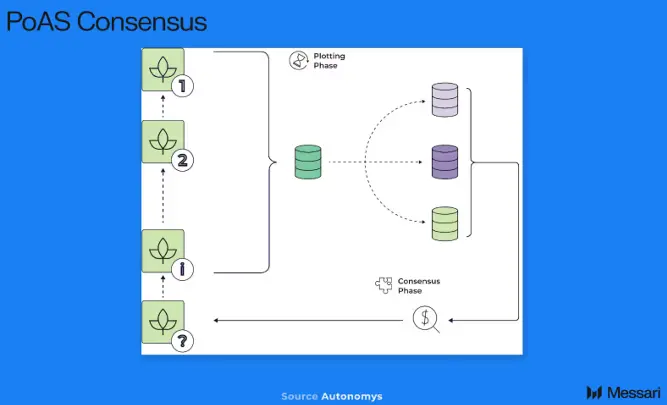
The successful operation of the PoAS consensus mechanism relies on the support of various cryptographic primitives, including hash functions, digital signatures, erasure codes, KZG polynomial commitments, Merkle trees, and encoding mappings.
Decoupled Execution
Decoupled Execution (DecEx) separates the consensus mechanism from transaction execution, significantly reducing the hardware requirements needed to participate in consensus. This design makes the storage space widely available on modern electronic devices the only core resource for participation. Unlike traditional blockchain nodes that need to handle both consensus and computation simultaneously, DecEx introduces two specialized roles for hardware-constrained users: (i) Farmers (miners) and (ii) Operators. Farmers participate in the PoAS consensus mechanism by providing storage space, responsible for maintaining the availability of blockchain historical data and transaction ordering without executing complex computations or maintaining a complete blockchain state. This role greatly lowers the participation threshold. Operators are generated through a staking-based election mechanism and are primarily responsible for executing transactions and managing state transitions in a dedicated environment called "Domains."
Domains are modular, independent execution environments designed for specific applications or scenarios, such as smart contracts or decentralized AI training. They leverage the security and data availability of the underlying consensus layer while providing flexibility, scalability, and interoperability. By distributing execution tasks across multiple domains, the network achieves horizontal scaling, with each domain handling a portion of transactions, thereby reducing bottlenecks and increasing throughput. Autonomys has launched several domain-based practical application products: Auto ID is a domain specifically for managing human and AI Agent identities. Nova is a permissionless EVM domain for deploying and running smart contracts.
Miners
In Autonomys Network, the primary responsibility of Farmers (miners) is to maintain consensus. Miners plot segments of the Archival History data onto their hard drives and mine blocks and voting rewards by mining the created plots. Additionally, miners join the Distributed Storage Network (DSN) as data retrieval nodes. The DSN is a network composed of miners who plot archival historical data segments, providing data storage, retrieval, and replication services to clients. It is responsible for distributing and maintaining data within the network, ensuring data availability and reliability.
Miner Dilemma
With the help of Subspace, Autonomys Network successfully addresses the "miner dilemma." In Proof-of-Capacity (PoC) blockchain systems, the "miner dilemma" arises from the need for miners to weigh between two choices: (i) using limited storage resources to maintain the state and history of the blockchain; (ii) maximizing storage commitments for participation in consensus. Rational miners typically choose the latter to increase their chances of obtaining rewards, but this may lead them to operate in a lightweight client manner, causing the network to trend towards centralization. The solution provided by Autonomys Network is to allow miners to maintain only minimal state and historical data, thus retaining the advantages of full nodes without bearing excessive storage burdens. Consensus is achieved through proof of replicated storage of blockchain history, with this data distributed by miners according to hard drive capacity limits. By decoupling consensus from computation, miners' responsibilities focus on proposing transaction orders, while state maintenance and computation transitions are handled by operator nodes. This design not only lowers the hardware participation threshold, incentivizes miners to participate through block rewards and transaction fees, but also further promotes the decentralization of the network.
Distributed Storage Network (DSN)
Autonomys Network employs a multi-layer Distributed Storage Network (DSN) to ensure the continuous availability and accessibility of blockchain data while avoiding the need for any single miner to store the entire history of the blockchain. The DSN achieves efficient verification and dynamic availability through technologies such as consistent hashing, erasure codes, and Kademlia distributed hash tables. These technologies work together to ensure data integrity and adapt to the dynamic joining or exiting of miners. Each data segment is replicated approximately the same number of times in the DSN to enhance data reliability. The DSN is divided into multiple collaboratively operating layers: Data Fragment Caching Layer (Layer-2) uses distributed hash tables to achieve nearly instantaneous data retrieval, supporting fast access; Archival Storage Layer (Layer-1) serves as the foundational "cold storage" layer responsible for the persistence and redundancy protection of long-term data, and is also a core pillar of the Dilithium consensus; Content Delivery Network Layer (Layer-3) enhances data retrieval speed to approach Web2 levels, providing users with a smooth experience. This architecture successfully addresses the storage inflation problem by distributing the growing blockchain data among miners while ensuring efficient data management and access.
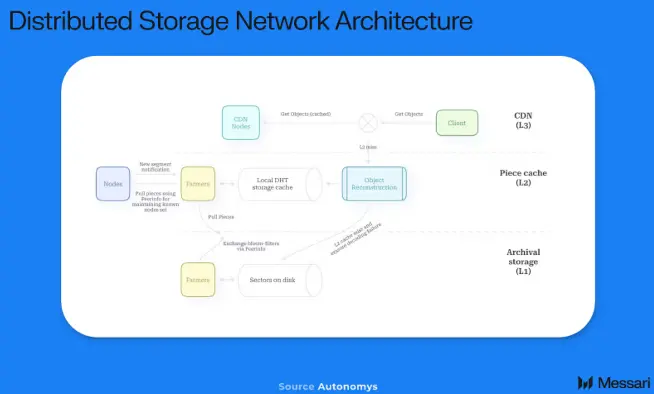
To incentivize user participation in the DSN, Autonomys Network has designed a unique algorithm that dynamically adjusts the on-chain storage prices based on supply and demand changes. This mechanism clarifies three main roles for network participants:
- Farmers are responsible for maintaining the consensus layer. Miners joining the DSN need to retrieve data for node synchronization and return the data to various clients.
- Domain Operators are responsible for ensuring the activity of the execution chain and receive rewards for their contributions.
- Timekeepers provide security for the network by maintaining the Proof-of-Time (PoT) blockchain. Their work includes preventing long-distance attacks and ensuring the randomness of block proposals.
Data Flow
The flow of data and its storage is at the core of Autonomys Network's uniqueness. To understand the data flow process, it is essential to grasp several key steps from transaction submission to data being permanently archived.
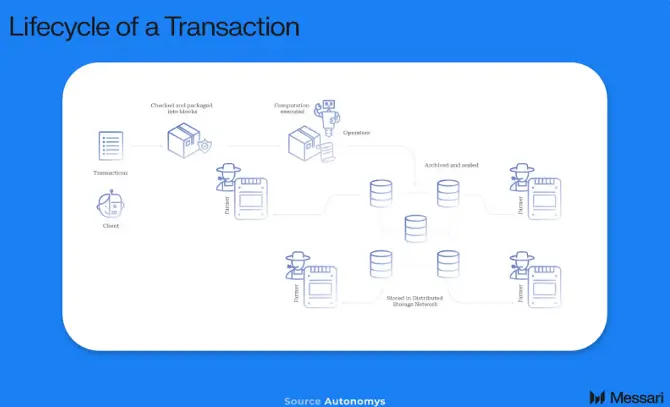
- A transaction is executed after being verified, triggering a state change.
- When the block containing the transaction reaches a certain depth (currently set at 100 blocks), it enters the archiving process.
- These newly archived data segments are added to the miners' cache via the DSN. This means that these data segments will be encoded into the miners' plot files on their hard drives for permanent storage according to the Plotting protocol.
Based on this process, clients can request data at any time and reconstruct the original data using these archived segments.
Staking
In Autonomys Network, staking involves Operators and Farmers, both of whom play different roles as previously mentioned. Operators earn execution fee rewards based on their staking ratio. Farmers receive rewards based on their committed storage capacity and can use their held tokens to nominate a specific operator to increase that operator's total stake, thereby enhancing their chances of becoming a slot leader. In return, Farmers receive a portion of the fees earned by the operators they nominated. The reward system employs a dynamic issuance model that adjusts rewards based on block height and block space demand to incentivize early adopters and ensure long-term sustainability. The fees within the network are used to cover operational costs and promote efficient resource utilization, with transaction fees encompassing storage and computation costs to reasonably compensate participants.
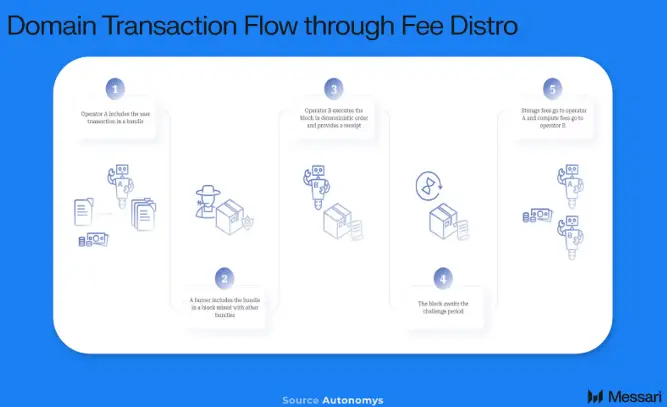
Each transaction requires a fee that consists of two parts: storage fee and computation fee. The storage fee is calculated based on the byte length of the transaction and the current storage capacity of the network, covering the costs of storing the transaction in the block and archiving it in the DSN. The computation fee is calculated based on the weight of the transaction, reflecting the computational resources required to execute the transaction. This fee compensates operators for their computational work in processing transactions. Additionally, operators can earn Domain Block Fees by executing transaction bundles in the allocated domains. These fees are distributed to operators who successfully submit execution receipts (Execution Receipt, ER) to prove the validity of their state transitions.
Node Functions
Autonomys Network includes three types of nodes, each with specific functions:
- Full Nodes: Default configuration, primarily responsible for the following duties: (i) forming the core backbone of the network; (ii) processing blocks and providing services to other nodes; (iii) ensuring data integrity and network health.
- Archival Nodes: An extension of full node functionality, preserving the entire blockchain history, which is particularly important for block exploration and historical data analysis. Archival nodes are maintained as a public resource by the Subspace Foundation.
- Light Clients: Designed for resource-constrained devices, they do not need to store the complete blockchain state and rely on full nodes for data retrieval and network interaction.
Ecosystem
Space Acres
Space Acres is an application that anyone can run on their computer to earn AI3 tokens. The application allows computers to run miner nodes in the background, contributing unused hard drive space to the network.
AI Agent
Auto ID is a decentralized digital identity system deployed on domains, supporting the creation of digital identities for both humans and AI Agents. It provides a Self-Sovereign Identity (SSI) framework that enables individuals to prove their identity without relying on biometric verification. Its main features include: (i) self-sovereignty, allowing users to decide what information to share, ensuring privacy through encryption, zero-knowledge proofs, and verifiable credentials; (ii) verifiability, using cryptographic proofs to validate the authenticity of identity claims without exposing personal information; (iii) universality, allowing Auto ID to issue identities for any entity, whether human or artificial intelligence, establishing a unified identity standard in the digital ecosystem; (iv) diversity, supporting self-issuance, third-party issuance, and multi-party joint issuance of identities to meet various use case needs; (v) interoperability, enabling seamless integration with existing identity systems and decentralized identifiers (DIDs).
Auto ID also integrates a mechanism called Auto Score for "Proof-of-Personhood" (PoP) to assess the likelihood that a user is human without exposing personal privacy. Auto Score calculates a probability score to prove human identity by aggregating various evidence, including verifying official documents, linking social media accounts, and participating in decentralized networks. These verifications are primarily completed through zero-knowledge proofs (ZKPs) to ensure user privacy is fully protected.
Auto ID and Auto Score play a crucial role in building content provenance and data sovereignty. By providing entities with the ability to generate digital signatures, they can create verifiable and tamper-proof authenticity records for created content, closely linked with Auto ID. In an era where the boundaries between human-created and machine-generated content are increasingly blurred, the importance of this functionality becomes even more pronounced. With Auto ID, users can securely delegate authority to AI Agents and define specific task roles and permissions based on their needs.
Through the standardized digital identity and data provenance framework provided by Auto ID and Auto Score, Autonomys Network uniquely interprets the necessity of verifiable human-machine interaction, privacy-first verification mechanisms, and data traceability. This framework serves as a touchstone, allowing potential users to gain insight into why such a path is crucial in an increasingly AI-driven world.
Autonomy's Github provides the necessary tools for AI Agents to utilize the DSN to achieve the ability to store memories and context on-chain. This means that Agents can directly store and retrieve data from the blockchain, maintaining persistent memory and context. This functionality enables Agents to perform more complex tasks, adapt to dynamic environments, and provide end-users with personalized and context-aware interactive experiences, as fully demonstrated in Autonomy's Auto Chain Agent demonstration.
Astral
Astral simplifies user participation in the Autonomys Network's PoAS system by: (i) providing a user-friendly interface for managing staking activities; (ii) serving as a block explorer. As the Autonomys network continues to evolve, Astral's role in facilitating operator participation and supporting decentralized governance within the network is expected to further enhance.
Token Economics
AI3 is the native token of Autonomys Network, with a total supply of 1 billion tokens. Approximately 65.00% of the tokens will be minted at the launch of the first phase of the mainnet in November 2024. Tokens will not be transferable before the official token generation event (TGE), which is planned to coincide with the launch of the second phase of the mainnet, expected in the first quarter of 2025.
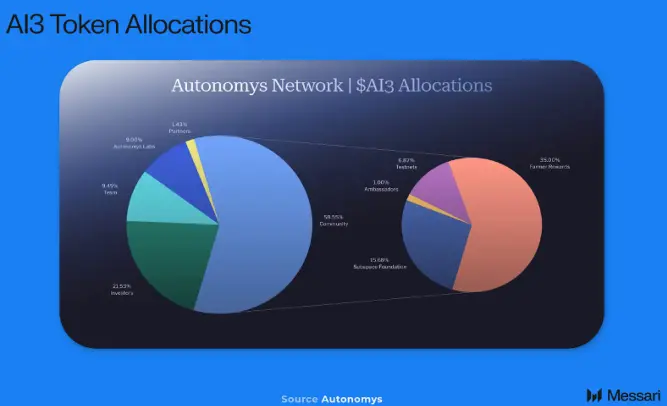
Investors, the team, Autonomys Labs (DevCo treasury), Subspace Foundation (long-term treasury), and partners collectively receive 494.5 million AI3 tokens, accounting for approximately 76.08% of the initial token supply or 49.45% of the maximum token supply. These tokens are subject to a 12-month lock-up period and a 36-month linear release plan, with proportional releases each month. At the end of the 12-month lock-up period, 25.00% of the tokens will be unlocked, and the remaining 75.00% will be released linearly over the subsequent 36 months at a rate of 1/36 per month.
155.5 million AI3 tokens (approximately 23.92% of the initial token supply or 15.55% of the maximum token supply) will be allocated to Autonomys Labs (operational activities), Subspace Foundation (operational activities and short-term treasury), ambassadors, and participants of the testnet/Stake Wars. This portion of tokens is not subject to the linear release plan, but certain participants (such as ambassadors) may have special release plans based on specific needs.
The remaining 35.00% of the maximum token supply will be distributed to miners (Farmers) and operators (Operators) in the form of block rewards over approximately 40 years.
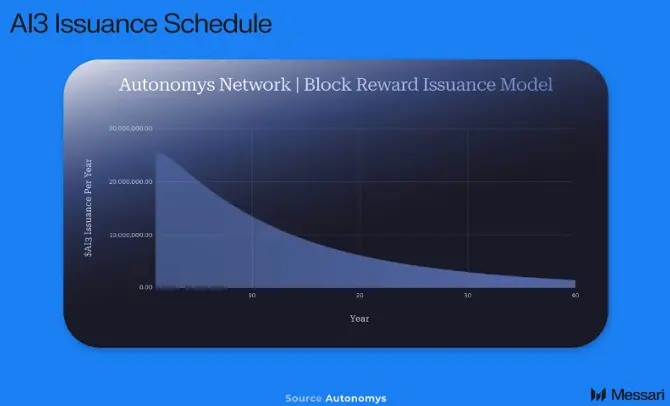
Roadmap
With the launch of the first phase of the mainnet, Autonomys Network plans to initiate the second phase in the first quarter of 2025. The second phase of the mainnet will deploy the Domain Layer and Nova EVM (which is currently live on the Tarus testnet) and will enable the transfer and release functions of the tokens. The third phase of the mainnet is expected to launch in 2026, aiming to implement a scalability roadmap that includes the realization of data sharding capabilities.
Summary
The modular design of Autonomys Network allows it to scale efficiently to meet the growing user demands and increasingly complex AI ecosystem, while maintaining a high level of security and decentralization through specialized security measures at various levels. Features such as Decoupled Execution (DecEx), Domains, Proof of Archival Storage (PoAS), Distributed Storage Network (DSN), and staking collectively form the foundation for the open, collaborative, and human-centered AI future that Autonomys strives for. Autonomys Network is committed to ensuring that everyone has equal access to transformative technology, a vision that aligns with the spirit of pioneers like Satoshi Nakamoto, driving us toward a new era where AI is a public good—accessible, fair, and aligned with human values.
免责声明:本文章仅代表作者个人观点,不代表本平台的立场和观点。本文章仅供信息分享,不构成对任何人的任何投资建议。用户与作者之间的任何争议,与本平台无关。如网页中刊载的文章或图片涉及侵权,请提供相关的权利证明和身份证明发送邮件到support@aicoin.com,本平台相关工作人员将会进行核查。




